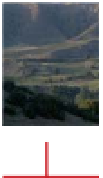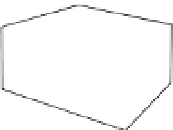Geology Reference
In-Depth Information
Joint sets
The most common type of joint is
extensional in origin, and is formed
either by contraction of the rock, or
because it has been subjected to an
extensional stress. Such joints are often
filled by vein material such as quartz
or calcite that has been deposited by
percolating solutions. Under ideal con-
ditions, sets of extensional joints will be
perpendicular to the direction of exten-
sion of the rock, that is, the minimum
principal stress, but often the orienta-
tion of such joints is very variable. In
sedimentary rocks, joint sets are often
both parallel to bedding and at right
angles to it (
cross joints
). Where the
bedding is folded, sets of cross joints
may occur parallel to the fold axes
(especially along the fold crests) and
also at right angles to the fold axes; the
latter are termed
longitudinal joints
and indicate that some extension has
taken place parallel to the fold axis.
Another type of joint is a shear
fracture formed under compression,
similar to a small-scale wrench fault.
Pairs of such shear fractures may
form in such a way that the smaller
angle between them is bisected by
the compression direction. Sets of
shear joints thus mimic the idealised
fault sets illustrated in Figure 5.11
and may comprise both thrust-sense
and strike-slip sets. Such joint sets are
useful in identifying the orientation
of the stress field acting on the rock.
It is important when interpreting
joints to recognise that early-formed
joints in bedded rocks will become re-
oriented during folding. For example,
cross-joints that were originally parallel
may become more radial and open up
on fold crests, as seen in Figure 6.2B.
P2
P1
P3
5
P1
P3
P1
40
41
P2
P3
P2
A
C
B
wrench faults
normal faults
thrust faults
Figure 5.11
Orientation of shear faults in relation to principal stress axes.
A.
Normal fault set:
maximum principal stress P1 vertical, minimum principal stress P3 horizontal.
B.
Thrust fault
set: maximum principal stress P1 horizontal, minimum principal stress P3 vertical.
C.
Wrench
fault set: maximum and minimum principal stresses, P1 and P3 both horizontal.
Where both the maximum and
minimum principal stresses are hori-
zontal, two sets of wrench faults can
form, their orientations bisected by the
maximum stress axis (Figure 5.11C).
displacement rates typically vary in the
range 5-15 mm/yr (
see
Chapter 12).
Observations over many decades on
certain sectors of the San Andreas fault
in the western USA, which is a plate
boundary, reveal a pattern of rather
higher average slip rates of 3-4 cm/yr
made up of long periods of quiescence
interrupted by seismic events result-
ing from displacements of the order
of several metres, indicating that the
crust experiences a slow build-up of
strain over long periods of time before
being suddenly relieved by rapid move-
ments generating an earthquake.
Only the normal fault set-up is
common in nature, and is typical of
regions having experienced crustal
extension. Thrust sets are usually highly
asymmetric, and appear to be driven
by an overall shear sense in a particular
direction; that is, they are subject to
kinematic, or movement-based, control
rather than dynamic, or stress-based
control. Wrench fault sets are similarly
asymmetric, being often parallel to large
regional transform faults. However, the
dynamic model of shear-fault orienta-
tion is much more useful in interpret-
ing joint patterns, as explained below.
Joints
All rock outcrops display numerous
cracks or small fractures that generally
lack obvious signs of displacement and
are too small in scale to be classified as
faults. Such cracks are termed
joints
.
Joints typically form sets with similar
orientations and origins, although
in many cases they are irregular and
unsystematic. Because erosion pref-
erentially attacks the joints, the rock
outcrop may become carved into a
series of blocks defined by the joint
surfaces (e.g.
see
Figure 5.12A).
Rates of displacement on active faults
Studies using precise ground position-
ing by GPS and InSAR methods have
established rates of displacement
along a number of important, presently
active, strike-slip faults. In several of
the major active faults in Tibet, such as
the
Altyn Tagh
and
Karakorum
faults,



















Search WWH ::

Custom Search